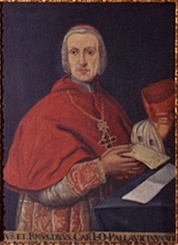Top Qs
Timeline
Chat
Perspective
Lazzaro Opizio Pallavicino
Italian cardinal From Wikipedia, the free encyclopedia
Remove ads
Lazzaro Opizio Pallavicini or Pallavicino (30 October 1719 – 23 February 1785) was an Italian Catholic cardinal and archbishop starting in 26 September 1766.


Biography
Summarize
Perspective
Lazzaro Opizio Pallavicini was born in Genoa on 30 October 1719 into the noble Pallavicini family of the Genoese patriciate. He was the son of Paolo Girolamo, a senator of the Republic of Genoa, and Giovanna di Luciano Serra. He was also the nephew of Cardinal Lazzaro Pallavicino (1602–1680).
He pursued an ecclesiastical career and studied at the University of La Sapienza in Rome, where he earned a doctorate in utroque iure (both canon and civil law). He later became a referendary of the Supreme Tribunal of the Apostolic Signatura. On 8 November 1751, he was appointed governor of the province of the Marca Anconitana.
He received minor orders on 18 February 1754, was ordained subdeacon on 24 February, deacon on 10 March, and priest on 19 March 1754. On 1 April 1754, he was appointed titular archbishop of Lepanto and received episcopal consecration on 7 April from Cardinal Federico Marcello Lante Montefeltro della Rovere. On 16 April 1754, he was named Assistant at the Pontifical Throne. He served as Apostolic Nuncio to the Kingdom of Naples from 21 May 1754 until 9 February 1760, and then as Nuncio to Spain from 1760 to 1767.[1]
He was created Cardinal Priest in the consistory of 26 September 1766 and appointed papal legate to Bologna on 1 December of that same year. He received the red hat and the title of Santi Nereo e Achilleo on 20 June 1768. He participated in the papal conclave of 1769, which elected Pope Clement XIV. On 19 May 1769, he was appointed Cardinal Secretary of State. He also participated in the conclave of 1774–1775, which elected Pope Pius VI. He served as Camerlengo of the Sacred College of Cardinals from 29 January 1776 to 17 February 1777.
On 14 December 1778, he opted for the title of San Pietro in Vincoli. On 3 October 1783, he was appointed plenipotentiary ambassador tasked with concluding treaties with the Republic of Venice.
He died in Rome on 23 February 1785. His body was exposed in the Basilica of Santa Maria sopra Minerva, where the funeral was held. In accordance with his wishes, he was buried in the Church of San Nicola da Tolentino in Rome.
Remove ads
References
Wikiwand - on
Seamless Wikipedia browsing. On steroids.
Remove ads
